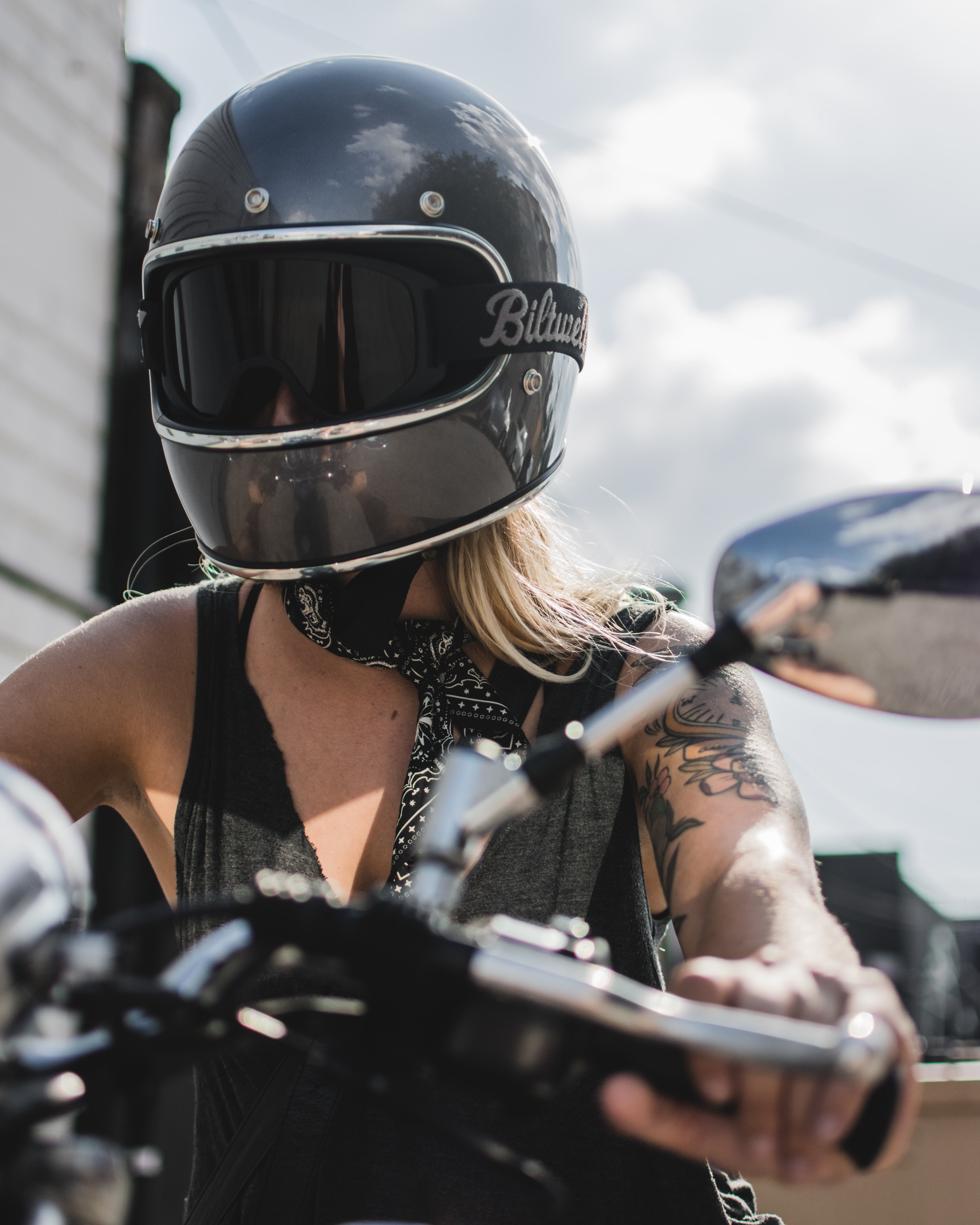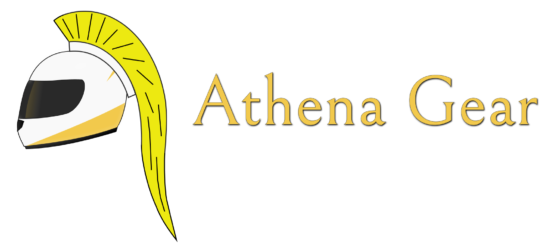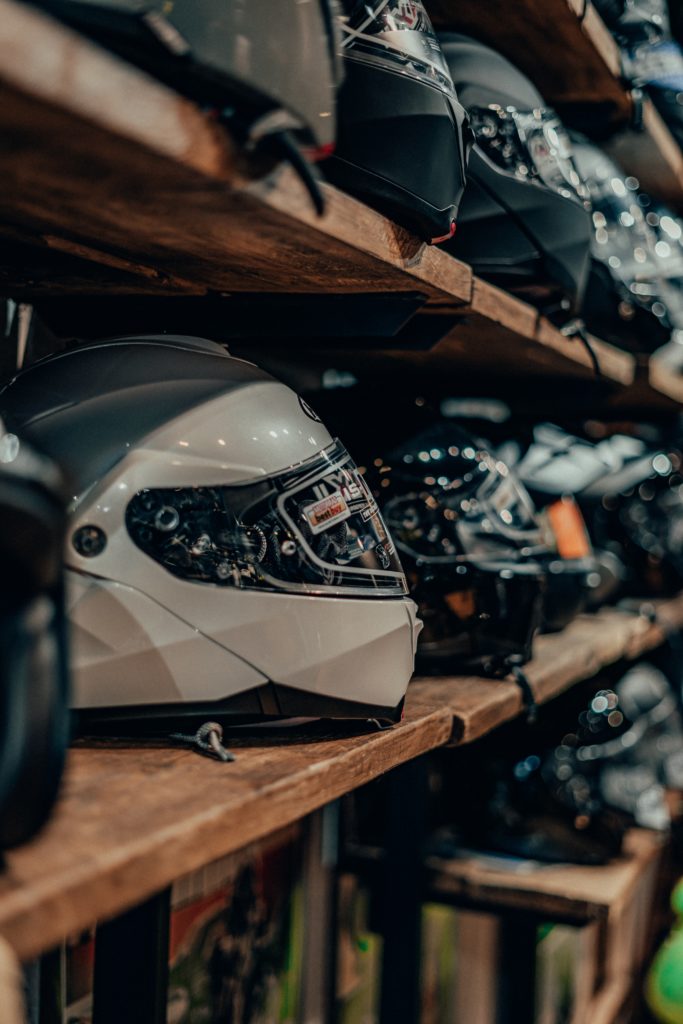Gear Guide: Motorcycle Helmets
Helmets are the first piece of motorcycle gear most riders buy, and for good reason. Helmets reduce the risk of death by 37%, and the risk of head injury by a whopping 69%, similar to how much seat belts reduce the odds of death or injury in a car crash. Unlike seat belts though, motorcycle helmets come in many varieties and need to be fitted specifically to you to work properly, and their usable life is much shorter. Here’s what you need to know.
Bottom Line:
- Get a full-face helmet, or a modular if you must
- Proper fit is a must for proper function. Buy a helmet that’s just a smidge tight all around, with no pressure points.
- Check that the helmet is at least ECE 22.05, Snell, or FIM certified, in addition to DOT approved.
- Ensure the helmet is newer than 5 years by checking the label under the lining
- Buy new helmets only, never used. Even if you buy from a friend you trust, the helmet could easily be damaged during shipping.
1) Choose a Style
Like most other motorcycle gear, helmets come in a variety of styles with varying safety and aesthetics. Full-face helmets are the safest, but they don’t work if you leave them at home because your 15-year-old half helmet is comfier. Buy the helmet that best suits your riding style.

Full face helmets with a non-moveable chin bar provide the best protection from anything the road can throw at you, whether that’s crashing, bugs, wind noise, or road debris. They are available in different styles for racing, urban, off road, and dual sport riders.

Modular helmets with a flip-up chin bar are the next safest. With the chin bar locked down they look and feel like full-face helmets, but you can flip up the chin bar up to talk, eat and drink, or just have more ventilation. In the event of a crash though the chin bar is weaker than a full face helmet and could snap off, leaving your chin exposed to the asphalt.

Open face or 3/4 helmets come next, and must be worn with a visor or separate goggles to keep bugs and debris out of your eyes. They leave most of your face, particularly the nose and chin, exposed in the event of a crash. The chin is the region with the highest number of impacts in accident reports, so these are not recommended.

The nicest thing you can say about half helmets, or “brain buckets” as they’re sometimes called, is that they’re better than nothing. These helmets look similar to a construction hard hat or bicycle helmet and protect the same area, the crown of the head. They may be appropriate for construction work or riding a bicycle, but certainly not for riding a motorcycle.
2) Check the Safety Rating
After the manufacturer produces them, helmets are certified and tested by local authorities before being offered for sale to the public. While the US only requires helmets to be DOT approved, most riders will want to choose a helmet with a higher certification such as FIM, Snell, ECE, or Sharp testing. Here’s how the ratings compare:
- FIM Homologated: This is the highest safety rating a helmet can hold, certification from the Fédération Internationale de Motocyclisme or FIM, motorcycle racing’s global governing body. if you’ve seen MotoGP racers crash at 150 MPH and walk away unharmed, they have the FIM to thank. The standard is quite new and not all helmets and helmet sizes have been tested, but if you can find an FIM helmet you’ll know you have the best protection possible.
- Snell Approved: Before the new FIM certification, Snell was the highest safety rating a motorcycle helmet could hold. Following the death of racecar driver Pete Snell in the 1950’s, the Snell Foundation was formed to test racing helmets for a variety of crash types, including pointed and blunt impacts to the face shield, chin bar, and other zones, the possibility of helmets being pulled off the wearer’s head, and the possibility of the wearer’s head turning inside the helmet. The Snell certification is race-oriented, so keep in mind that features appreciated by non-racers like drop-down sun visors will not pass, though the helmet may be “safe” otherwise.
- SHARP Testing: SHARP stands for Safety Helmet Assessment and Rating Program, and is run by the British government. Helmets must be ECE approved in order to be eligible for SHARP testing, as only ECE-approved helmets are sold in the UK. SHARP methods are similar overall to Snell, but SHARP testing is more road-oriented while Snell is more race-oriented. SHARP testing also does not issue a pass/fail grade or a “SHARP certification”, but instead rates helmets on a scale of 1-5 stars.
- ECE Approved: Any helmet sold in Europe must be approved by the ECE, the Economic Commission of Europe. The current standard is ECE 22.05, though 22.06 is likely to be released soon. ECE approval is seen as the minimum safety rating for many riders throughout the world, not just in Europe.
- DOT Approved: Any helmet sold in the USA must be approved by the Department of Transportation, or DOT. While the testing itself is similar to Snell but with somewhat lower standards, the issue with DOT certifications is that many have not held up to these standards when retested by independent labs. This has led to a widespread mistrust of helmets that carry only a DOT approval.
Apart from the safety certification, you’ll also want to be sure that the helmet is younger than 5 years–look for a label on the inside of the helmet, behind the liner. A helmet’s impact protection comes from several layers of foam with different densities. These layers are stacked around your head like an onion and glued together, then finally topped with a plastic or composite shell. After 5 years of being in different conditions and cycling through heat and cold, the foam and glue can no longer be trusted. There’s no good way to inspect the inside of the shell, so after 5 years they’re done. Keep this in mind if you see a helmet on sale, as it may already be 2 or 3 years old.

One last point is never to buy a used helmet. We’re big proponents of buying used here at Athena Gear–Reduce, Reuse, Recycle after all–but you can never be sure what was done with a helmet before you got it. Every time a helmet is dropped the foam inside the shell compresses to absorb the impact and the shell itself might not show any damage. Since there’s no way to inspect the foam to see if it’s been compressed, you have to assume the previous owner abused it. You’ll also need a way to get the helmet sent to you without it being damaged along the way. You may trust the previous owner, but unless you can pick it up in person or they still have the original packing material, it’s likely to be damaged in transit.
If you yourself have accidentally dropped a helmet, use your judgement. If it shows no damage after falling, empty, off the seat of your bike onto flat ground, it’s probably ok. If it had something heavy inside it or fell a long way onto a hard edge or point though, it’s probably worth replacing. Console yourself by picking out a new graphic and consider that you can reset your 5-year counter before you buy the next one.
3) Find the Right Fit
No matter what safety certification a helmet carries, it can’t protect you if it flops around on your head or you leave it at home because it doesn’t fit. Unlike jackets that are relatively easy to measure for, helmets are made of rigid materials like fiberglass, so both the shape and size of your skull are important. The good news is that most brands only make one shape of helmet, so once you find one that fits you’re likely to fit all the other helmets from the same brand. Until then though, it’s best to go to a store in person to try on different brands.
- Find a helmet you like and try on the smallest size possible. It should feel snug but not pinched or painful when you put it on.
- Walk around the store with the helmet on, paying attention for any hot spots, pain, or pressure points. These usually occur at the center of the forehead or temples. Pain at the forehead means that the helmet is too round for your head, so your head itself is likely either an “intermediate oval” or “long” shape. Pain at the temples means the helmet is too narrow for your head, so your head itself is likely either an “intermediate oval” or “round” shape. Of the major brands, Arai tends to be very round, Icon tends to be very narrow/long, and the rest fall somewhere in the middle. Salespeople are usually very knowledgeable about different brands and can help you find yours faster.
- Repeat step 2 with different brands or sizes until you find one that you can wear comfortably for 15-20 minutes. When you take off the helmet, you’ll likely have some lines pressed into your face but there shouldn’t be any red or white marks.
- Once you have a helmet that fits your skull, look at the cheek pads to see if they fit correctly or if you have to swap out the pads for another size. You should have a little bit of “chipmunk cheeks” in the helmet, but not so much that you bite the inside of your cheeks when you close your mouth. Have someone hold the helmet still while you try to turn your head inside–your skin should stay stuck to the helmet and not slide at all.
Keep in mind that the majority of riders, especially women, are wearing helmets that are too large for them. You may even need to consider children’s helmets if the brand’s adult line doesn’t fit your head. Having too large of a helmet though means that it won’t protect you like it’s supposed to, and may even cause injuries if the forehead slides down to smack into your nose. Remember, your helmet should just slightly push in your cheeks and not slide at all on your head.
Too Loose


Just Right


4) Common Helmet Features
In the past, helmets that were more expensive actually were safer, but with the development of modern safety standards like Snell this has become less the case. Now, spending more money on typically means you get a lighter, quieter, more compact, better ventilated, or better-looking helmet. Here are some common helmet features to choose from:
- EMS Removal Tabs: These small fabric loops are a safety feature that makes it easier for first responders to remove your helmet after a crash without needing to tug at your head and neck. If a crash injures your back, first responders will try to immobilize your back, neck, and spine until you can be transported to a hospital where it’s safer to treat you, and these tabs make it easier for them to do their job.
- Flat Area to Attach Devices: All helmets are curved, but many will have an area along the jawbone that runs flat so you can securely attach devices like your Sena or GoPro. This is convenient, but potentially less safe since the devices might catch on the ground in a crash and injure your neck and head.
- Noise Reduction: While you should always wear earplugs on a motorcycle, some helmets are also engineered to reduce the amount of wind buffeting and wind noise that goes along with it. Schuberth is particularly famous for this. Note that less noise often means less ventilation too.
- Pinlock Anti-Fog Visors: These are special anti-fog lenses made with a clear “spongey” coating of water-absorbing material to soak up condensation. Pinlock visors are made specific to each helmet brand and model, so a Pinlock AGV will not fit a Shoei or vice versa.
- Removable (washable!) liner: Sweat, makeup, hair grease and products, sneezes… helmets can get gross inside. Having a liner you can remove and wash or replace makes this much more manageable.
- Riding Profiles: Depending on whether you’re buying a helmet for racing, city riding, or off road riding, you’ll have the option of different helmet profiles. Helmets meant for racing are engineered to be more aerodynamic when you’re in a tuck, and will have a taller viewing window so you can see farther ahead. City riding helmets may look similar, but are typically made to be more aerodynamic while sitting upright and often have more comfort features like noise reduction. Off road helmets often have a removable sun shade and a more pointed profile, which helps when you’re climbing a hill on dirt but can be obnoxious in the wind on a highway.
- Sunken ear indents for speakers: If you have a Sena, PackTalk, or any other audio device for your helmet, having an area to nest the speakers will make your helmet more comfortable for your ears.
- Transitions visor: Any helmet will have options for different shades of visor, but a Transitions visor is filled with invisible particles that respond to UV light and become dark when it’s bright out, or clear when it’s dark out. They lose sensitivity over time, but are very convenient if you don’t want to carry around a spare visor for if it gets dark or starts raining.
- Ventilation: Even a budget helmet will typically come with a vent at the mouth and another over the forehead, but nicer helmets will have more vents and better options to adjust them so you do less fumbling with gloved hands. Note that more ventilation often means more noise too.
- Weight-reducing materials: All helmets are based around multi-layer foam to absorb impacts and a hard plastic or composite shell to protect the foam and distribute the impact over as much of the foam as possible. Plastics like ABS are common in entry-level helmets, and while they are cheap to manufacture they are typically heavier. Composite materials or resins like Kevlar, carbon fiber, and fiberglass offer the same strength as plastics at a lighter weight so the helmet overall is lighter. They can’t be molded like plastics though, and so cost more to make.

